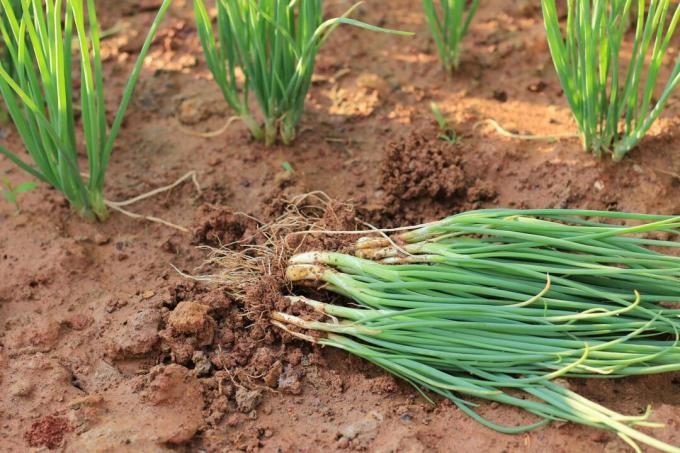Spring onions can be harvested almost all year round. We provide tips on harvesting, storing and preparing spring onions.

Spring onions (Allium fistulosum), also known as winter hedge onions or spring onions, can be harvested for almost the entire gardening season if they are grown in batches and sown early. The bulbous plant (Allioideae) is hardy and persistent. Therefore, the long, green leaves or individual stems can be harvested as spring onions every year. An alternative to the perennial cultivation of spring onions is cultivation in batches. To do this, only one or two rows of spring onions are sown every two weeks. The time offset, which you can of course vary, allows you to harvest new, whole spring onions over and over again. With this cultivation method, the vegetable farmers ensure a continuous supply of the supermarkets. Below are tips for harvesting and storing spring onions.
contents
- Harvesting spring onions: when and how do you go about it?
- Store and preserve spring onions
- Can you freeze spring onions?
- Preparation and use
- How healthy are spring onions?
Harvesting spring onions: when and how do you go about it?
Because the spring onions can be sown during the entire frost-free period, there is no fixed harvest time. In warm weather and in a well-chosen location, the spring onion needs between two and three months from sowing to the first harvest. As a rule, the plants are brought in as spring onions, i.e. as entire plants, with a size of 25-30 cm. You don't have to pay much attention, because the shafts are simply pulled or dug out of the earth. In the case of clumpy growing, perennial winter hedge bulbs, only individual stems or the onion green are harvested so that the plants can recover. If you decide to cut the spring onions, make sure that at least 5 cm of the stem are left above the ground. In this way, the growth center is preserved and the onion plant sprouts fresh leaves again. Spring onions can also be harvested in winter if the weather is frost-free. Brown or mushy leaves are removed immediately and land on the compost or in the organic waste bin.
How long can you harvest spring onions? Depending on the time of sowing or planting, you can harvest spring onions around two to three months after germination. Perennial winter hedge bulbs are ready for harvest all year round in frost-free weather.

Store and preserve spring onions
Spring onions cannot be stored for long because they do not have a protective skin like potatoes, for example (Solanum tuberosum). Bulbs keep the longest at 0 - 2 ° C and a relative humidity of 80%. If you store spring onions in the refrigerator, the tender stems will keep for about a week. However, the leaves quickly begin to turn brown and wither. This can be remedied by wrapping the shafts in a damp cloth.
An alternative is to store rooted spring onions in a glass of water, ideally at cool temperatures below 10 ° C. Here, however, there is a rapid loss of flavoring substances. At best, you only harvest small amounts of spring onions that can be consumed fresh and quickly.
What's the longest way to keep spring onions? Fresh spring onions keep the longest in the refrigerator if they are wrapped in a damp cloth.

Can you freeze spring onions?
Freezing is a good way to store green onions for extended periods of time. Due to the sub-zero temperatures, the valuable ingredients are almost completely preserved, which means that frozen spring onions are very healthy. In preparation, they should be washed, cleaned and then patted dry. Now you cut the freshly harvested spring onions into small pieces and then pack them in freezer bags or boxes. Frozen spring onions will keep for about six months. They can be added to a wide variety of dishes towards the end of the cooking process as they thaw very quickly. Although the ingredients are retained through the freezing, the consistency is after the Unfortunately, defrosting is no longer as crispy as we are used to from a fresh spring onion are. But they are just as suitable for cooking as fresh spring onions.

Preparation and use
Spring onions can be made just like that Kitchen onion (Allium cepa) to use. The white part of the spring onion is not particularly aromatic compared to the leaves, but is better suited for frying and cooking without losing its consistency. On the other hand, the green leaves can develop their full aroma in salads, starters and spreads. The spring onion is an indispensable part of many Asian dishes such as soups, wok dishes and curries. In the case of dishes served hot, you should add the green leaves just before serving, otherwise the consistency will be very soft.

How healthy are spring onions?
The spring onion is healthy, mainly because of its low calorie content. This is due, among other things, to an indigestible form of sugar, the so-called fructan, which the spring onion forms. Our intestinal flora is very happy about this multiple sugar, because the fructan has a similar effect to fiber. Furthermore, spring onions contain the sulfur compounds typical of onion plants, such as alliin. They not only provide the unmistakable onion taste and tears in the eyes when cutting, but also have an antibacterial and anti-cancerogenic effect. In addition, the healthy spring onion contains various minerals and vitamin C.
Spring onions are easy to grow in your own garden and even on the balcony. We give tips on site selection, sowing and for Planting spring onions.



